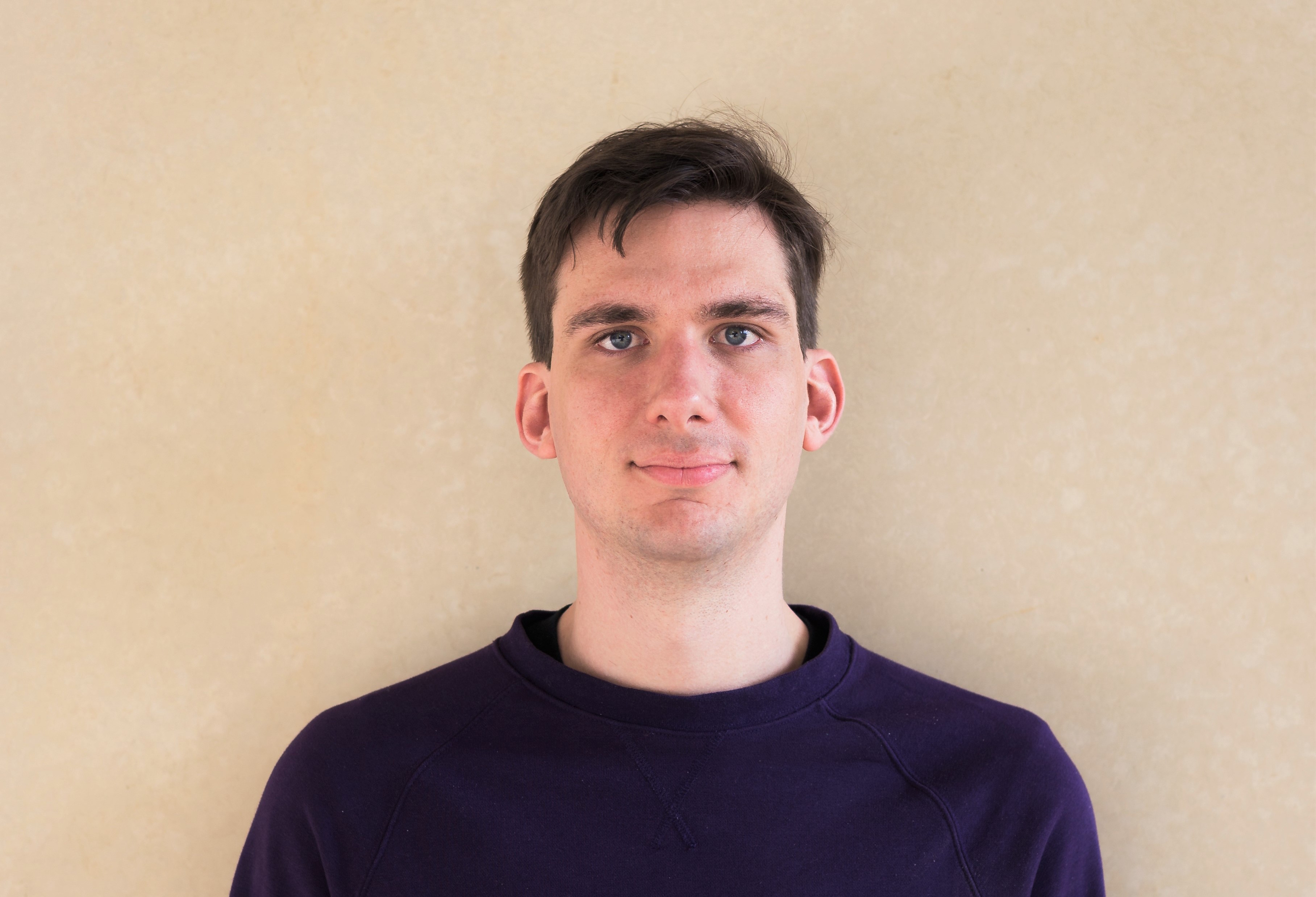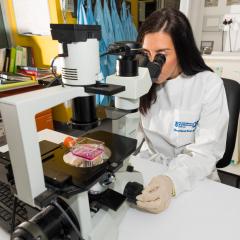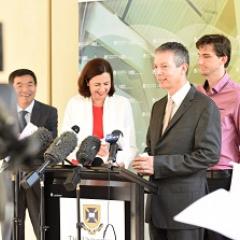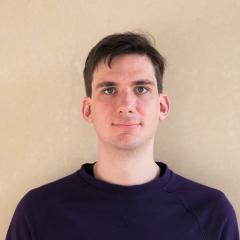Podcast: Understanding, preventing and treating dementia

QBI researchers are doing all they can to understand and develop new treatments for dementia. In this episode, Dr Gerhard Leinenga explains the different types of dementia, whether it's possible to reduce the risk of getting it, and exciting QBI research from the Clem Jones Centre for Ageing Dementia Research that has reduced the symptoms of Alzheimer's in animal models.
Transcript
Donna Lu: By the time you finish listening to this podcast, at least two people who have been diagnosed with dementia, which can involve changes to personality, intelligence, independence and all of the experiences and memories that make us unique. Terry Pratchett, who passed away with dementia in 2015 captured the hopelessness of his situation when he said: “I'm slipping away at bit at a time and all I can do is watch it happen.” The Queensland Brain Institute is doing everything we can to research dementia from a basic science level through to examining new technologies and potential treatments. We need to find answers for those living with dementia as well as to support their family and carers. Today, we speak to Dr. Gerhard Leinenga, post-doctoral research fellow at the Clem Jones Center for Ageing Sementia Research. Gerhard explains how dementia affects the brain, the different kinds of dementia and shares an exciting research discovery.
Dr. Gerhard Leinenga: So, dementia is actually a number of different medical conditions that negatively impact cognition and they get worse over time. That's something that they all have in common and there's a number of different types of dementia of which the most common is Alzheimer's disease and everybody would have heard of Alzheimer's disease. It accounts for most of the cases of dementia, but there are other kinds of dementia such as vascular dementia, frontotemporal dementia, dementia with Lewy bodies and a number of other maybe rarer types of dementia.
Donna Lu: So, in the Clem Jones Center for Ageing Dementia Research, what types are you and all the researchers are studying?
Dr. Gerhard Leinenga: So, the main two conditions that we're studying in the Clem Jones Center for Ageing Dementia Research, Alzheimer’s disease, as well as some types of frontotemporal dementia.
Donna Lu: So, can you talk us through what happens in the brain in Alzheimer's disease?
Dr. Gerhard Leinenga: In Alzheimer's disease, what we know is that there’s damage occurring in the brain of an Alzheimer's disease patient and so when we see the brain of an Alzheimer's disease patient at autopsy, we see that it's much smaller than a normal brain of a healthy person of the same age and when we look under a microscope, we see that there’s a buildup of aggregates in the brain. So, these toxins, the main two kinds in an Alzheimer's disease brain are amyloid, which are plaques that occur throughout the brain in the extracellular environment, and there's also a buildup of tau aggregates within neurons. And it's believed that these two components of the pathology are responsible in some way for the symptoms of Alzheimer's disease because they prevent neurons from functioning correctly.
Donna Lu: So, these proteins do we know why they build up?
Dr. Gerhard Leinenga: That's part of the area of research that we look at the Clem Jones Center for Ageing Dementia Research and we know that for amyloid for example, that this is a peptide that is produced from a larger protein and those different biochemical steps that lead to the production of a small protein, the amyloid-beta peptide which has the ability to cluster together and form amyloid plaques which are damaging to the brain. But the other protein tau, which builds up in the brain we know less about why this occurs and why aggregates form, but we believe it's related to modifications that occurred in the protein after it's made and this increases with age.
Donna Lu: So, with Alzheimer’s disease there’s a buildup of proteins but for something like vascular dementia, the process is actually quite different. Can you talk us through what happens in vascular dementia?
Dr. Gerhard Leinenga: So, vascular dementia which is believed to be the second most common form of dementia after Alzheimer's disease - about ten to twenty percent of cases of dementia are due to vascular causes - what is believed to be happening is that there's not enough blood supply getting to the brain and this could be due to a stroke or it could be due to hardening of the arteries and the narrowing of the arteries such as the carotid arteries and so the brain is starved of nutrients and oxygen over a long period of time and this causes some of the symptoms of dementia. But there isn't the same protein aggregation occurring as there is say in Alzheimer's disease.
Donna Lu: I guess something like vascular dementia begs the question as to whether cardiovascular health or disease I supposed, heart disease, high blood pressure, diabetes and smoking - do those factors play a role in your chances of developing this sort of dementia?
Dr. Gerhard Leinenga: So, it's definitely believed that cardiovascular risk factors are important in developing some forms of dementia and if you have Alzheimer's disease it's also possible that you could also have an element of vascular dementia or other pathologies occurring in your brain. So, with age, there are a number of changes and things that can go wrong so it's important to keep your, trying keep your brain healthy for multiple aspects.
Donna Lu: Are there ways people can reduce their risk of getting dementia?
Dr. Gerhard Leinenga: So, there was a big study published recently that found that there are anumber of risk factors for Alzheimer's disease. It was interesting that one of the main environmental risk factors that they identified was middle-age hearing loss which can lead to social isolation and reduced stimulation, so that was an issue that was an environmental factor that they thought could be solved. But keeping in good health generally as people say help the mind requires a healthy body and so it's definitely true that there are environmental factors that can reduce your risk or delay the onset of the development of dementia.
Donna Lu: So, as I understand it, about one-third of the risk of developing dementia is attributed to these modifiable risk factors, so to speak - do, things like regularly getting a good night's sleep, exercising, eating healthily, minimising the number of head injuries you get for example. There's still about two-thirds of the risk that you can't change. I guess we don't have any control over things like genes, is that right?
Dr. Gerhard Leinenga: I think what that large study found that was published in ‘The Lancet’, was that if you could modify all of the environmental factors that we know contribute to dementia such as cardiovascular disease, social isolation, hearing loss, etc. that you could reduce the number of people in the world with dementia by one third, if you could remove all of these negative environmental impacts, but that still leaves a number of cases that have genetic causes or which aren’t easily modifiable by environmental interventions.
Donna Lu: What type of genes are involved in dementia?
Dr. Gerhard Leinenga: When you talk about the genetics of dementia it's clear that there are rare genetic risk factors, so these cause what's called a familial or genetic form of the disease. So, there are patients that have familial Alzheimer's disease and these patients typically develop the symptoms of Alzheimer's in middle age, so much earlier than a typical Alzheimer's disease patient and this runs in families. And then there are risk factors that APoE gene which is a very common gene - in fact, everyone has a variant of this gene which influences the risk that you'll have Alzheimer's, depending on which kind of allele of this gene that you inherit.
Donna Lu: And, for our listeners who don't know what an allele is, can you explain a little bit further?
Dr. Gerhard Leinenga: An allele is like a version of the gene and in humans there’s three types of the APoE allele or three variants of the gene: two, three and four. And you inherit two versions, one from each parent and so it's known that people who are unfortunate enough to inherit the four-four allele, two copies, are up to seven times more likely to develop Alzheimer's disease.
Donna Lu: But, it's not all bad news fortunately. Your work specifically has found a breakthrough using ultrasound to treat Alzheimer's disease in animal models. Can you tell us about that?
Dr. Gerhard Leinenga: As a first step we did some studies in an Alzheimer’s disease mouse model. So, what we did is treated the animals with ultrasound and this was combined with injection of microbubbles which are a contrast agent, which is used in a doctor's surgery to normally to image the heart. And so, what we were interested in finding out was what would the effect of opening the blood brain barrier in mice do and could we use it to treat the symptoms of Alzheimer's disease. What we were thinking as a long term goal was using drugs that are not very effective at getting into the brain, combining this with the blood brain barrier opening by ultrasound. But interestingly, what we found in the study was that ultrasound alone, so without injecting a drug just the ultrasound which allows molecules that are normally present in the blood to get access to the brain, we found that this reduced the Alzheimer's pathology, the amyloid plaques in their brains. And what we also found is that this made them better able to learn mazes, so their memory and learning was improved.
Donna Lu: So, is this the first time that researchers have been able to reduce or even I guess reverse the symptoms of Alzheimer's?
Dr. Gerhard Leinenga: There are a number of studies that have shown that amyloid plaques can be reduced in animals, but these and these studies involved drugs, so it was mainly antibodies and so there are currently antibodies in clinical trials but they have yet to prove their effectiveness in enough patients so that this can become a therapy. But the advantages of our approach is that this is a noninvasive or minimally invasive technique which wouldn't require the administration of expensive drugs and we hope could be performed readily in a doctor's surgery for example.
Donna Lu: Can you explain what the blood-brain barrier is, what its normal function in the brain is?
Dr. Gerhard Leinenga: So, the blood-brain barrier exists around all of the capillaries and blood vessels in the brain. And it's actually a physical barrier that's made up of very tight connections, or tight junctions between the endothelial cells which line the walls of blood vessels in the brain. So what this normally does is prevent all molecules except for a very tiny lipophilic ones from entering into the brain. So, this makes brain diseases quite hard to treat. But the blood-brain barrier is believed to be there to protect the brain against toxins but also to maintain the homeostatic environment which is most ideal for neuronal firing and normal brain activity.
Donna Lu: So, the blood brain barrier is a protective mechanism, so it prevents say bacteria and viruses from entering the brain. Is there any danger that opening the blood-brain barrier even temporarily can let some of these nasty things in?
Dr. Gerhard Leinenga: In our studies where we use this technique of the ultrasound and microbubbles to open the blood-brain barrier, we find another number of important things. So, the first is that you can open the blood-brain barrier and this is temporary, so after several hours the blood-brain barrier goes back to its normal impermeable state. The second is that we could do this weekly and open the blood-brain barrier again once a week and that it would become impermeable again as it previously did. A third is that we found that there was no damage to the neurons; so we didn't find that the neurons changed, and they didn't shrivel up and they maintained the normal firing activity when we did an electrophysiological study. And another important finding was that the size of the opening isn't large enough for bacteria and large viruses to go through. So, the size of the opening still provides some protection against, say, an infection from reaching the brain.
Donna Lu: The research found that the ultrasound alone was enough to remove or reduce the amount of amyloid plaques in the brain. Do we know why this happens?
Dr. Gerhard Leinenga: Looking at the brains after the ultrasound treatment the most interesting finding that we had was that the amyloid, which normally exists in plaques with a certain cell type of the brain, the microglial cells dotted around them but these microglial not containing very much of the amyloid plaque. What we found is that in the animals that had been treated with the ultrasound that these cells contained a lot more amyloid. In fact, there were areas of the brain where all of the amyloid was contained within these microglial cells and it's believed that this is one of the normal jobs of the cell type in the brain is to remove the buildup of aggregated proteins, but when the system becomes overwhelmed, either because there’s too much production or that become less effective at clearing these amyloid plaques, this is when you get the symptoms of Alzheimer's disease or the Alzheimer's pathology building up. And so what we think is that this is a way to activate and improve the normal activity of the cell type in the brain, the microglia.
Donna Lu: So, would it be fair to say that the microglial are a kind of like the garbage collectors of the brain, that kind of chomping up all of these waste products?
Dr. Gerhard Leinenga: So, that's definitely one of the functions of these cells that has been identified and there’s some evidence that an Alzheimer’s disease these cells become less effective at this important task.
Donna Lu: In an update to the research, this original discovery was made in 2015, but earlier this year the team in the Clem Jones Center for Ageing Dementia Research and I know that involved you found that using ultrasound in combination with an antibody treatment was actually more effective. Tell us about that new discovery.
Dr. Gerhard Leinenga: That two points to make about our latest research, is that if focused on a different animal model of Alzheimer's disease that targets the second important pathology in Alzheimer's disease, the aggregation of tau protein in structures that are known as neurofibrillary tangles. And so what was found there in an animal with the second kind of pathology was that ultrasound alone did have an effect to reduce the tau pathology, but it was made much more effective by an antibody drug, a particular kind of antibody that was designed in the Clem Jones Center for Ageing Dementia Research to specifically target tau proteins and that the combination. So where you applied the ultrasound for the purpose of increasing the levels of this antibody in the brain, this was the most effective at both reducing the amount of the tau protein in the brain and improving the mice’s normal behavior.
Donna Lu: So, without the ultrasound, how much, perhaps as a percentage or a proportion of antibodies targeting Alzheimer's disease, actually would make it into the brain?
Dr. Gerhard Leinenga: So, it depends on the antibody but it's believed to be about 0.1%. So, if you administered a thousand antibody molecules only one would be able to sneak past the blood-brain barrier. But with ultrasound we're able to increase this a several-fold.
Donna Lu: That was Dr. Gerhard Leinenga, talking about dementia. If this podcast has raised any concerns about your health, please visit your local G.P. For more information about dementia, go to qbi.uq.edu.au. Our next episode, we'll discuss in more depth the exciting ultrasound treatment being developed in the labs here at QBI. That's all for today's episode. I'm Donna Lu and our podcast was produced by Jessica McGaw. If you enjoyed this episode, tell your friends about it .Give us a review on iTunes or let us know what you think on Facebook or Twitter. Thanks for listening.



